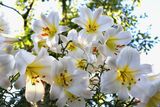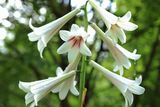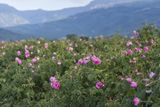Top Gardening advice from Diarmuid Gavin: Take a walk on the wild side
By scattering some well-choosen seeds this week you can create your own meadow garden
Is there anyone who doesn't like the idea of a meadow? A lazy field full of sparkling colours, a garden style which appears to be easy to maintain, often using native plants which attract the birds and bees and provide the appearance of us living in harmony with nature.
Meadows are way better for our environment than lawns, they're very cheap to create - just the cost of packets of seeds - and often you can collect seed for the following year. Now that we've freed ourselves from the shackles of regimented bedding plants and rockeries, many of us are ready to embrace what can look like 'wild' gardening, even in suburbia. All you need for fairly instant impact is soil, some shelter and sunshine.
An annual meadow is easily achieved, will work on rich or poor soils and will make an impact for a single year.
Begin by digging over the soil, taking out weeds and rubbish, and raking it to a nice fine tilt. Leave for a week to allow any seeds you've brought to the surface to germinate, then remove these invaders by hoeing.
Put some planning into the choice of plants to achieve continuous displays right up to autumn. A good selection includes Cornflower (Centaurea cya us), Fairy Toadflax (Linaria macroccana), Californian Poppy (Eschschoizia californica), Candytuft (Iberis umbellata) Love in a Mist (Nigella) and Poppy (Pavander rhoeas).
Sew the seeds, mixed with some dry sand to achieve an even spread in March, April and May and, if it doesn't rain within a couple of days, sprinkle the area with water to help.
They will germinate quickly and produce a riot of very pretty flowers in eight or 10 weeks.
To develop a permanent perennial meadow, your preparation and maintenance is quite different. A lot more work is involved but the rewards can make it worthwhile. In short, you want to avoid rich fertile soils (they encourage growth in grasses which could become too rampant for your wild flowers).
It may be necessary to remove some topsoil from your plot, and sew direct into newly rotavated subsoil. Sewing takes place from autumn until late spring and your meadow will develop its own character, with certain species feeling at home and becoming dominant.
Some of the flower species that I've used creating meadows with some success in the past include: Common Self Heal (Prunella vulgaris), Heartsease (Viola tricolour), White camomile (Anthemis tinctoria 'Alba'), Evening primrose (Oenothera biennis), Purple mullein (Verbascum phoeniceum), Spike speedwell (Veronica spicata), Catchfly (Silene armeria 'Electra'), Musk mallow (Malva moschata), Black knapweed (Centaurea nigra), Greater knapweed (Centaurea scabiosa), Oxe eye daisy (Leucanthemum vulgare), St John's Wort (Hypericum perforatum) and Betony (Betonica officinalis). You will need to develop a management plan, which involves cutting the grass from July to September in an effort to keep seeds on the meadow. Leave the cuttings on site for a week or so to allow seeds be released into the soil, then remove.
To create a sustainable meadow of only Irish wild flowers I would get in touch with the local experts (see top tip) who can advise on what choices may be apt for your soil and location. Never sew plants that aren't native in open rural areas, you don't want them to spread and become a nuisance.
Lawns can be converted into wildflower meadows over time. To reduce their fertility don't add feed (or introduce weed killers), and when you mow the lawn always remove and compost clippings. Then, after a couple of growing seasons of this plan, let them grow.
Some wonderful wild flowers and grasses will make this easy meadow their home and you can help out by introducing young plants in plug form directly into the plot.
Top tip
Sandro Cafolla of Designs By Nature is an authority on Irish wildflowers and can sell you seed or help you create your dream meadow. During July he holds open days at his trial grounds in Carlow to demonstrate the potential of native Irish species. For information,
See wildflowers.ie
This week in the garden: get rid of dandelions
Dandelions can drive gardeners demented. They’re flowering at the moment so are easy to identify. They form a straight tap route and seed easily, meaning you’ll soon have a prolifetarion of yellow heads poking through your lawn or borders.
Digging them out is one option, making sure you get all the root. This can be backbreaking work, however, if a large number of plants have seeded.
Alternative measures inclue continually cutting off the plant’s foliage will weaken it to the point where it won’t survive.
Blocking its access to sunlight with heavy black polythene or an old piece of flooring lino will achieve similar results.
Or, ask your garden centre for a selective systemic weed killer, one that you spray or paint on individual leaves. This may need a couple of applications over a period of a few weeks but it will do the trick.
Join the Irish Independent WhatsApp channel
Stay up to date with all the latest news














